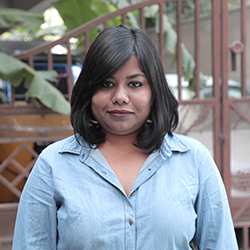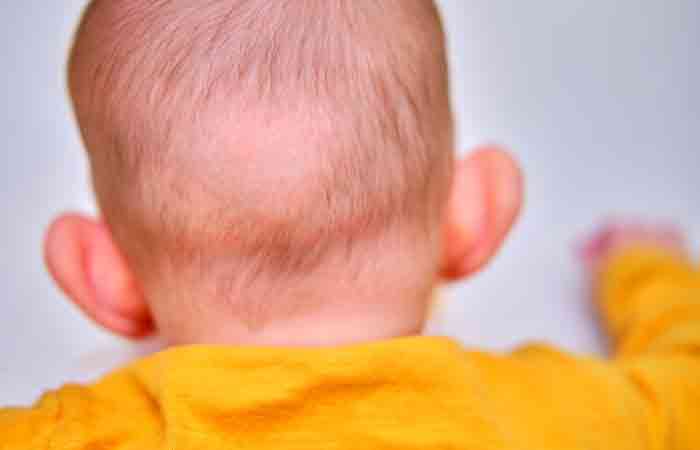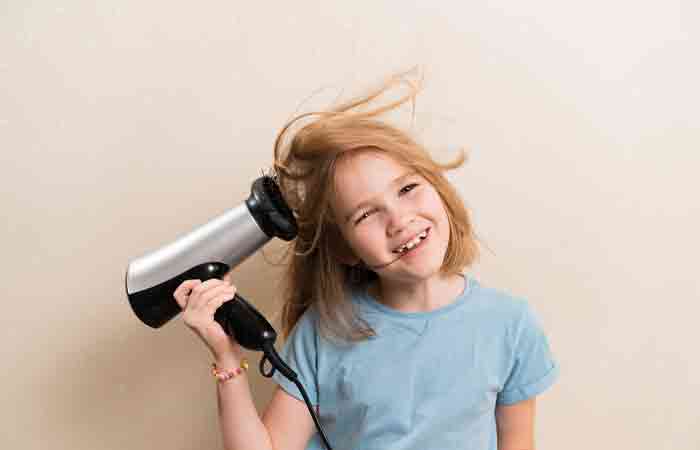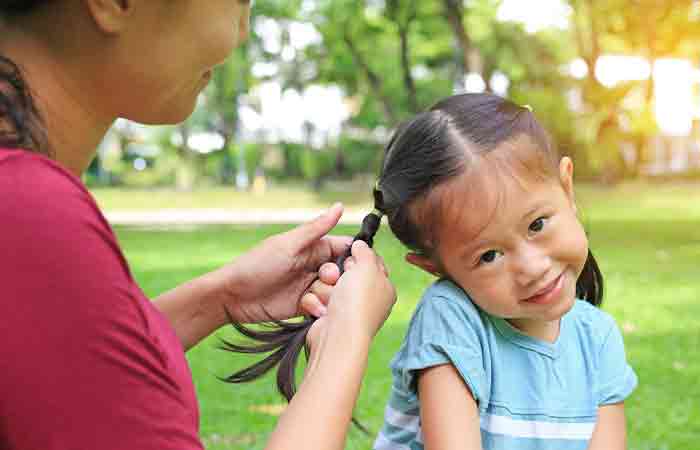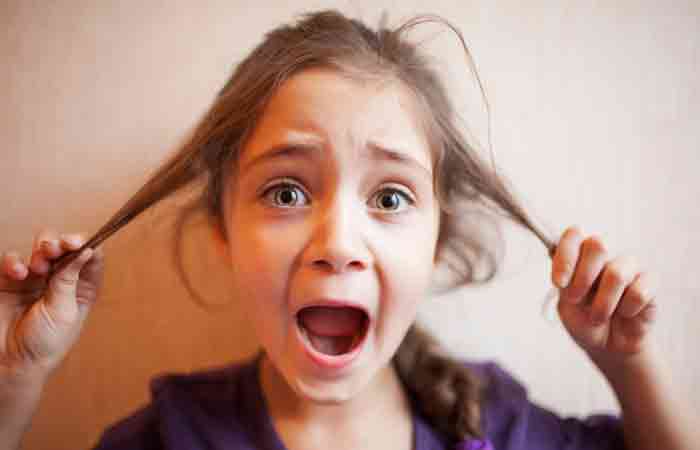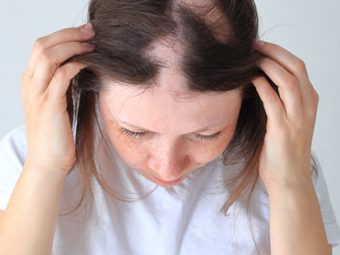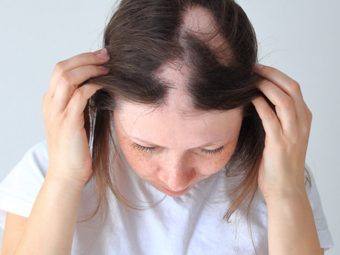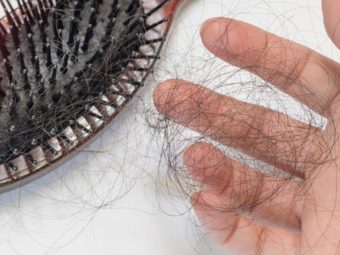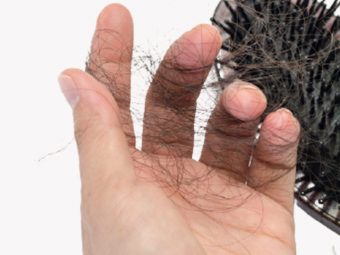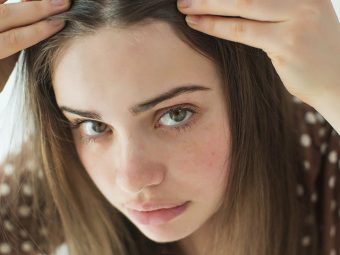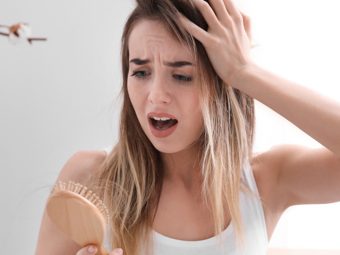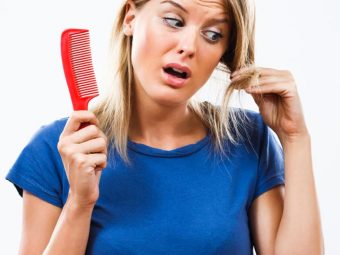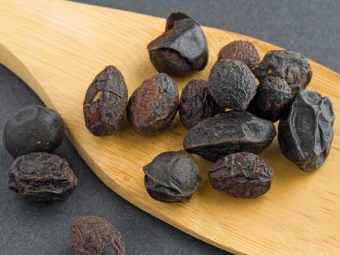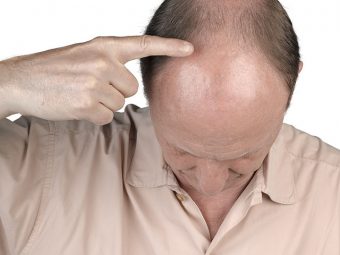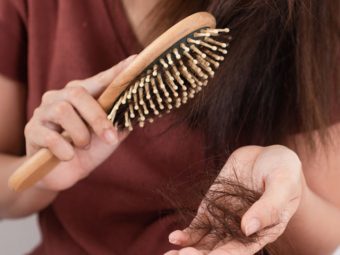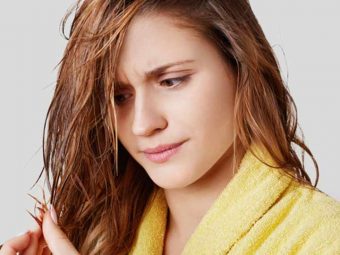What Are The Main Causes Of Hair Loss In Children?
Understand the medical conditions or stress that may be causing your child to lose hair.
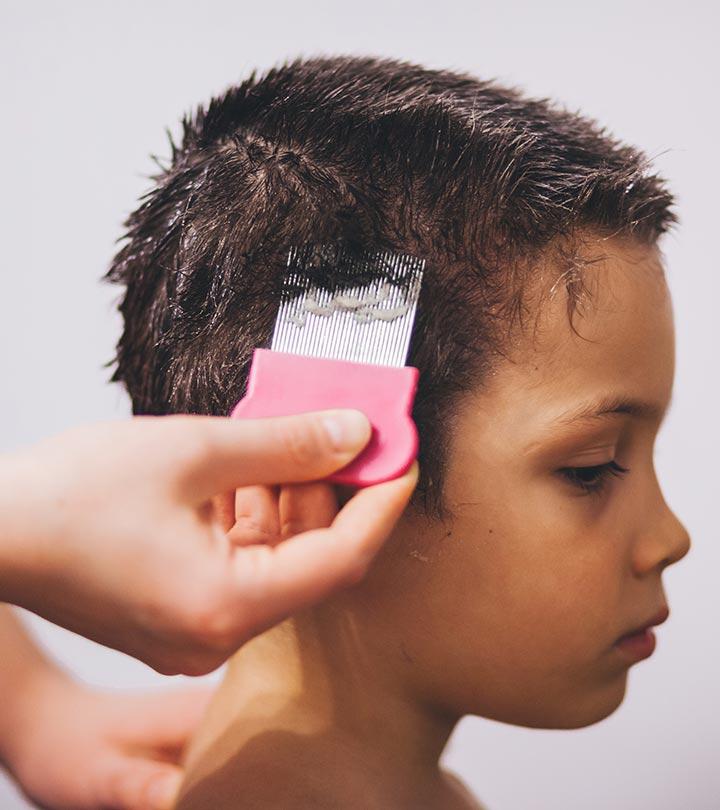
Image: Shutterstock
Seeing your child losing hair can be distressing. So, what are the causes of childhood alopecia or hair loss in children? This post is for you if you are having trouble determining the cause. Many studies have proven that there is a link between hair and self-image, psychosocial functioning, emotional well-being, and quality of life (1), (2). Hair loss in children, especially when it occurs at a young age, can have a profound psychological impact. Let us first examine the causes of hair loss in youngsters so that we may talk to them about developing confidence from within and find an acceptable solution to the situation. Keep reading!
A recent survey with 1662 participants was conducted with the aim to study the incidence of alopecia and how health-related factors played a significant role in it. The result found 37.4% more alopecia to be in individuals with a fatty scalp and also noted its negative effect on the quality of life of the students.
In This Article
Causes Of Hair Loss In Children
Various factors can cause hair loss in children. Some factors can be addressed without any medical intervention, while some require immediate attention from a physician. The causes of hair loss in children are categorized into two groups:
- Non-medical causes
- Medical causes
1. Non-Medical Causes Of Hair Loss In Children
Newborn hair loss, friction, use of chemicals, blow drying, and tight hairstyles are some of the common non-medical causes of hair loss in children.
(a) Newborn Hair Loss: Some newborn babies lose hair during the first six months of their birth to make way for new hair growth. This is absolutely normal and nothing to be alarmed about.
(b) Friction: Rubbing their head against rough surfaces, such as mattresses, carpets, and floors, can cause children to lose hair. Once they get rid of this behavior, their hair will start to regrow.
(c) Use Of Chemicals: The use of harsh chemicals for hairstyling processes, such as bleaching, dyeing, perming, or straightening, on children will damage their hair and cause it to fall out (3). Either avoid these processes altogether or switch to chemical-free and natural products.
(d) Blow Drying: Exposing your child’s hair to excess heat while blow drying, perming, or straightening it will cause their hair to fall out due to heat damage. Instead, you can blow dry their hair on the lowest heat setting and restrict the frequency of other heat styling processes.
(e) Tight Hairstyles: Pulling your child’s hair back with a comb or a hairbrush to tie it in tight ponytails, buns, or braids will harm the hair follicles, cause physical trauma to the scalp, and result in hair loss. You need to be gentle while detangling the hair and tie it in loose hairstyles to prevent hair loss.
2. Medical Causes Of Hair Loss In Children
Infections, diseases, or deficiencies, such as tinea capitis, alopecia areata, trichotillomania, telogen effluvium, hypothyroidism, and nutritional deficiencies, are some of the most common medical causes of hair loss in children (4).
(a) Tinea Capitis: Tinea capitis, also known as the ringworm of the scalp, is a scalp infection caused by fungi called dermatophytes. Overcrowding and poor hygiene can aggravate the infection as it spreads easily through physical contact and sharing of combs and other objects of personal hygiene. Patchy hair loss, black spots in the areas of hair loss, itching, redness, bumps on the scalp, brittle hair, swollen lymph glands, and low-grade fever are the symptoms of tinea capitis (5).
Dermatologists diagnose this infection withKOH microscopyi XA quick test on specimens of scrapings of skin to diagnose the presence of yeast or fungal infections. and Wood’s lamp examination (6). In simple terms, the physician examines your child’s scalp and sends a piece of the infected skin to a lab for diagnosis.
 Did You Know?
Did You Know?The affected child needs to take the prescribed antifungal drug for about eight weeks. Along with oral medication, using an antifungal shampoo prevents the spread of this infection.
(b) Alopecia: Alopecia areata is anautoimmunei XA condition in which the body attacks healthy cells as the immune system cannot differentiate between healthy cells and foreign cells. disease in which the immune system harms the cells in the hair follicles and causes the hair to fall out in patches (8). It can be genetic. Depending on the pattern of hair loss, alopecia is classified into three types::
- Alopecia areata – The hair on some parts of the scalp falls out, forming bald patches on the head.
- Alopecia totalis – All the hair on the scalp falls out Eyebrows and Eyelashes may fall out.
- Alopecia universalis – All the hair on the entire body falls out.
After examining the medical history of the child for cutaneous and systemic autoimmune disorders, physicians diagnose this disease by taking some hair from the child’s scalp and sending it for examination to a lab (9).
 Did You Know?
Did You Know?There is no cure for alopecia areata caused by immune system disorders. However, treatments involving the use of certain drugs, such as anthralin and minoxidil, or corticosteroid creams can suppress the symptoms , but does not help in the regrowth of hair (8), (9). These therapies may cause side effects. For those individuals wanting a more natural course of treatment may choose to use essential oils. With the right kind of treatment, children can regrow their hair within a year.
Sheridan Ruth, a blogger, recounted her struggle with alopecia as a child. In her blog, she writes, “One day I felt the hairdresser’s cold fingers against my scalp. It felt barer and more exposed than normal…. I had a bald patch about the size of a 50-cent piece.” She continues to highlight the difficulty of dealing with the reality of losing her hair, “Losing my hair as a child and the treatments that came along with it were sad and confusing. Confusing because the bright-eyed innocent part of me thought, well it’s okay, it’s just hair. It doesn’t matter. But I felt the impact of people asking questions and everyone around me trying to fix it, and part of me became ashamed of what my body was doing (i).”
(c) Trichotillomania: Trichotillomania is a form of obsessive-compulsive disorder characterized by an individual pulling out their hair out of a sense of compulsion. They do it on purpose, and some may even eat the hair they pull out. Patchy hair loss and broken hairs of varying lengths are some effects of trichotillomania (11). The hair can grow back once the child stops pulling it out.
Physicians usually diagnose this condition using a dermoscope. The process is called dermoscopyi XA noninvasive technique used for examination of the skin’s surface with an instrument consisting of a magnifying lens. .
The hair usually grows back once the child stops pulling it out. Besides consulting a dermatologist, you need to consult a psychologist as well. Cognitive Behavioral Therapy (CBT) aids in teaching your child to be more aware of pulling their hair and helps them understand the emotions that trigger such behavior, eventually prompting them to stop it (11).
(d) Telogen Effluvium: Telogen is the resting phase in a normal hair growth cycle. In this phase, the hair stops growing and rests so that the old hairs fall out and make way for new ones. Telogen effluvium is a condition in which the hair is pushed into the telogen phase (or the resting phase) prematurely, resulting in temporary hair loss. It can happen due to a stressful, shocking, or traumatic event. Children with this condition lose 300 hairs a day, unlike the average 100 hairs a day (12).
Microscopic examination of the shed hair, CBC, serum iron, serum zinc, low vitamin D and thyroid function tests are some of the ways to diagnose this condition.
This condition does not require any medical treatment in particular. Once the child is out of the stress or trauma, the hair grows back. It may take around six months to a year for the hair to grow back.
(e) Hypothyroidism: The thyroid gland in the neck releases two main hormones, T3 and T4, to control the body’s metabolism. Thyroid disorders or inefficiencies in the production of these hormones, i.e., an underproduction or overproduction, affects the body’s metabolism (13). The underproduction of thyroid hormones results in a condition called hypothyroidism. Fatigue, weight gain, joint and muscle pain, constipation, dry skin, and thin and brittle hair are some of the symptoms of hypothyroidism.
The thyroid function test can help diagnose this condition.
It can be treated by oral medication and intake of iodine along with nutritious foods. Once your child starts the treatment, the hair fall stops gradually. It may take a few months for the hair to regrow.
(f) Nutritional Deficiencies: Poor eating habits, resulting in the deficiency of vitamins, minerals, and protein, can cause your child’s hair to fall out (4). Psychological eating disorders, like anorexiai XAn eating and psychological disorder characterized by an intense fear of gaining weight, causing unhealthy and low body weight. and bulimiai XA psychological eating disorder that causes uncontrolled episodes of binge-eating followed by purging and fasting. , can also cause hair loss. Surplus of vitamin A or deficiency of iron or vitamin D zinc, niacin, biotin, protein, or amino acids also leads to hair loss (14).
Blood tests, urine tests, and other medical tests help in the diagnosis of nutrient deficiencies.
A healthy diet plan and nutritional supplements can assist in correcting the deficiencies, thereby aiding the regrowth of your child’s hair.
(g) Chemotherapy: If your child is undergoing chemotherapy or radiation therapy, both of which are strong treatments to fight off cancer, they run the risk of losing their hair (15). This is because chemotherapy stops the quick division of cells (including the cells in hair follicles) to prevent the spread of cancer (5). However, hair fall stops, and the hair regrows once your child is done with the treatment.
Other medical causes of hair loss in your child may include allergies, lupus, atopic dermatitis, psoriasis, and sickle cell anemia (4).
How Common is Hair Loss In Babies And Children?
Hair loss is common in children, just like in adults. However, the causes can be different. Note that it’s normal to lose about 100 strands of hair in a day.
You can perform a tug test to check if your child has hair loss issues. Gently pull a small section of your child’s hair. If more than 10% of hair falls out, it is a sign of hair loss.
But don’t worry. In most cases, hair loss is reversible. The best way to treat hair loss is to consult a trichologist or pediatrician.
Should You See A Doctor?
You should see a doctor when you notice hair loss in your child. They will diagnose the cause of the hair loss, and recommend specific treatment. The treatment may involve steroid injections, topical steroids, or oral medicines, depending on the severity of the condition. Steroid injections are mainly given to teenagers rather than younger children. The steroid treatments may stimulate hair regrowth by promoting the growth of hair follicles. A study found that a 6-week treatment with steroids may help people with alopecia areata regrow more than 25% of their hair. However, this improvement is temporary and comes with expected and short-term side effects (16).
It is important for parents to consult a healthcare provider, preferably a dermatologist or a pediatric specialist before starting any treatment. To diagnose the issues, the doctor may ask you questions about your child’s and your medical history. They may also suggest some lab tests. In most cases, hair loss is irreversible, but there may be a few medical conditions when it is permanent.
Hair loss can be traumatic for a child. And that is why you must talk to them and explain the situation.
How To Talk To Your Child About Hair Loss
Hair loss can be tough to deal with, especially for a child. It can have a psychological impact on them. You may notice that your child is more stressed (which can cause more hair loss) or less social.
The key to talking to your kid about their hair loss is to create a safe space for them. Let them know why they have hair loss and the possible treatments to regrow hair. You may want to talk to your child’s pediatrician and seek help from a therapist to help them.
If the hair loss is irreversible, consider alternatives like wigs, hair extensions, scarves, or hats. You can also try changing your child’s hairstyle to cover the bald spots. Speak to a professional hair stylist for cues on changing your child’s hairstyle. You can use hair filler products to make the hair look fuller. However, consult a doctor before using any product on your child’s scalp or if you are considering a hair transplant.
Infographic: Top 8 Causes Of Hair Loss In Children
Dealing with hair loss is not only disturbing for children but also for their parents. Sadly, it is a common condition that can develop due to an infection or an autoimmune disease. While this condition is not fatal, it can impact a child’s emotional well-being and self-esteem. If you want to know what really causes hair loss at this early age, check out the infographic below.

Illustration: StyleCraze Design Team
Save the high-quality PDF version on your device now.
Download Infographic
Several reasons can cause hair loss in children. It can be due to medical as well as non-medical causes. Tight hairstyles or improper hair styling practices, friction, use of chemicals, and blow drying are the non-medical causes, while there are other medical causes like alopecia, hypothyroidism, hormonal changes, and nutritional deficiencies that can cause early hair loss. It will be easy to treat if you identify the reason behind the hair loss as soon as you notice hair loss. Consult an experienced doctor and determine which treatment suits your child.
Frequently Asked Questions
How do I know if my child has alopecia?
Alopecia areata usually presents itself as one or several bald patches on the scalp that show no redness or scaling.
Which vegetables are good for hair growth?
Spinach, carrots, onion, sweet potatoes, tomato, beetroot, and French beans are some vegetables that are good for hair growth due to the presence of beta-carotene, vitamin A, antioxidants, and other nutrients.
Does vitamin D affect hair?
Yes. Vitamin D deficiency is linked to alopecia (15). It also plays a role in stimulating hair growth. However, do not take vitamin D supplements without consulting the doctor.
How to fix hair loss due to eczema in toddlers?
Eczema makes the scalp itchy, and aggressive scratching can lead to hair loss. Consult the doctor and use medicated shampoos, OTC products, and oral or topical steroids to reduce scalp inflammation.
Is it normal for my two-year-old’s hair to fall out?
Temporary hair loss is not uncommon in children and toddlers. However, consult a doctor if you notice excessive hair loss and bald patches.
Key Takeaways
- If your kid rubs their head against rough surfaces like floors or carpets, the friction can cause spot hair loss.
- Tying your kid’s hair tightly into ponytails can damage hair follicles and cause hair loss.
- If you have noticed your child frequently pulling their hair, chances are he or she has OCD. In such cases, consult a doctor to understand the problem thoroughly.
- Enrich your diet with vitamins A and D, iron, and amino acids, which will help promote hair growth.
Worried about your child’s hair loss issues? Gain valuable insights from this video that explores the potential causes and offers guidance on addressing this concern effectively. Check it out.
Personal Experience: Source
i. How It Started/How It’s Going: Part 1: Alopecia as I child;
https://sheridanruth.medium.com/how-it-started-how-its-going-part-1-alopecia-as-i-child-6065597b8248
Sources
- The Pyschological Impact Of Hair Loss Among Men: A Multinational European Study
https://www.ncbi.nlm.nih.gov/pubmed/16307704 - Treating Female Pattern Hair Loss
https://www.health.harvard.edu/staying-healthy/treating-female-pattern-hair-loss - Hair Cosmetics: An Overview
https://www.ncbi.nlm.nih.gov/pmc/articles/PMC4387693/ - Hair Loss in Children: Common and Uncommon Causes; Clinical and Epidemiological Study in Jordan
https://www.ncbi.nlm.nih.gov/pmc/articles/PMC3999647/ - Management Of Tinea Capitis In Childhood
https://www.ncbi.nlm.nih.gov/pmc/articles/PMC3047946/#!po=2.17391 - Common Tinea Infections in Children
https://pubmed.ncbi.nlm.nih.gov/18533375 - Tinea Capitis
https://www.ncbi.nlm.nih.gov/books/NBK536909/ - Alopecia Areata
https://www.ncbi.nlm.nih.gov/pmc/articles/PMC5573125/ - Current Treatment Strategies In Pediatric Alopecia Areata
https://www.ncbi.nlm.nih.gov/pmc/articles/PMC3519253/ - Epidemiology and burden of alopecia areata: a systematic review,
https://www.ncbi.nlm.nih.gov/pmc/articles/PMC4521674/ - Pediatric Trichotillomania
https://www.ncbi.nlm.nih.gov/pmc/articles/PMC3366724/ - A Practical Approach to the Diagnosis and Management of Hair Loss in Children and Adolescents
https://www.ncbi.nlm.nih.gov/pmc/articles/PMC5522886/ - A Descriptive Study of Alopecia Patterns and their Relation to Thyroid Dysfunction
https://www.ncbi.nlm.nih.gov/pmc/articles/PMC3746235/ - The Role of Vitamins and Minerals in Hair Loss: A Review
https://www.ncbi.nlm.nih.gov/pmc/articles/PMC6380979/ - Chemotherapy-Related Hair Loss (Alopecia) in Children
https://www.urmc.rochester.edu/encyclopedia/content.aspx?contenttypeid=90&contentid=P02732 - Systemic steroids with or without 2% topical minoxidil in the treatment of alopecia areata
https://pubmed.ncbi.nlm.nih.gov/1444500/



